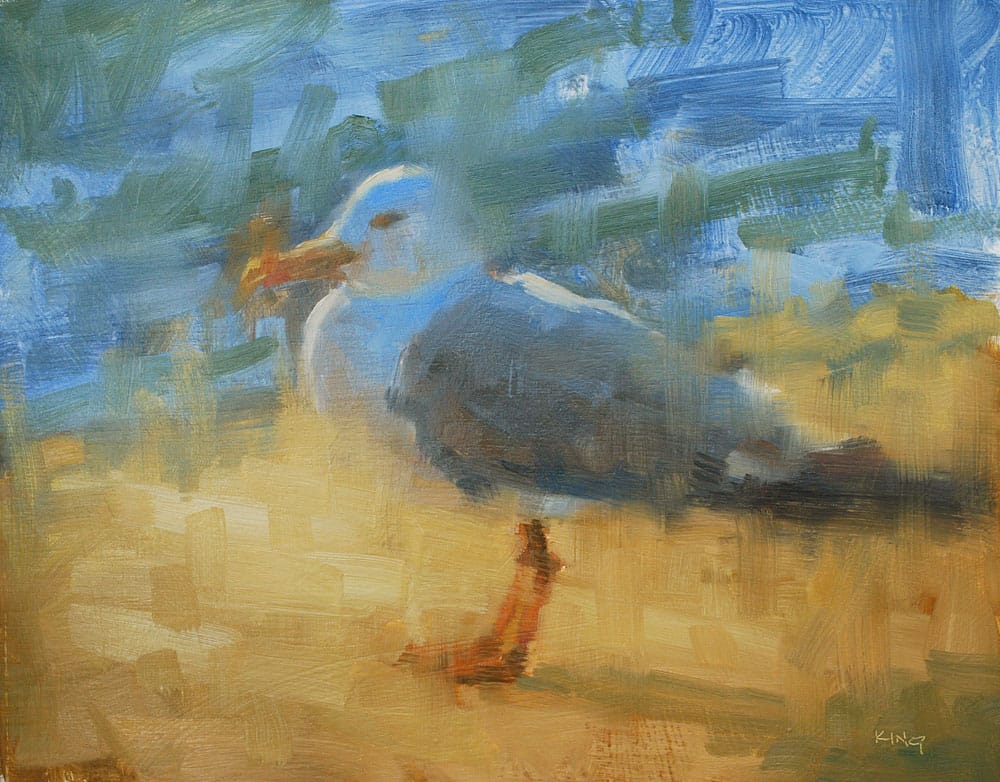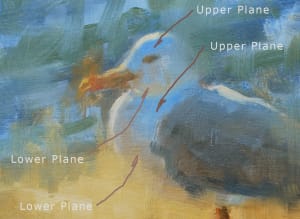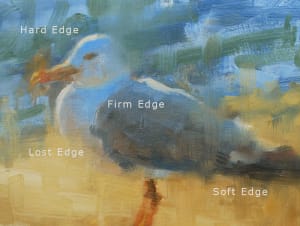This is an oil painting demo I recently painted for a group I regularly teach in Langley.
The focus of the demo was to how to see and paint the subtleties of colour reflection in the planes of an object depending on which way a plane faces. In other words, if the plane of an object is facing up, the colour of that plane will be influenced by the reflection of colour above it. This is easier to see on a white object, which made the seagull an excellent example to use.
The demo, however, ended up having many sub-topics to touch on, which, in my eyes, made it more valuable.
Planes and Reflected Colour :: The Main Demo
You can see in the planes facing up (the top of the head and the shoulder area) are heavily influenced by the blue sky. Whereas the downward facing planes of the underbelly and the lower part of the neck is influenced by the sand’s reflected colour.
I pushed this colour influence in the painting to get the main point across but to also show that doing so will not negatively effect the finished piece. In fact, it makes it more ‘colourful’ to the average viewer.
Shadow Temperature
The standard guideline for shadow temperature is warm light/cool shadows and vise versa.
However, in this case, the warm light, that should produce cool shadows, actually produced warm shadows on the downward facing planes due to the warmth of the sand colour reflecting into them.
Edges
I am also of the belief that a painting needs a defined focus and the rest of the work can be very loose with soft and lost edges, much like your eye sees the world.
Since I determined the focus was the head of the seagull, I started at the the tail and began to soften the edges throughout the work. As you can see, some were firm, most were soft and I mixed in lost edges, in the breast and back of the head, so the subject melts into the painting.
Painting Looser & More Impressionistic
With this demo only taking an hour and a half to complete, it is a good example that if a student wants to paint looser and more impressionistic, they should set a timer to limit their painting time.
Once the timer goes off, one should step back to review the work but not go back into it and fiddle. Just move onto the next.
Final Words
For me, painting is very cerebral, needing ones full attention and focus to create more than just an image. With the right concepts and guidelines under your belt it makes it much easier to know what to do next. With each step a new decision needs to be made before it can be called complete.




Very impressive and good points made, Michael. Like this one very much!
Enjoyed your comments Michael and the painting and of course seagulls is a favorite subject of mine. Thanks for sharing. cheers Jytte
I love your painting Michael, Good Job! Things like sea gulls and crows and such, can be very boring if you don’t use your imagination as well as your knowledge.
Thank you for sharing!